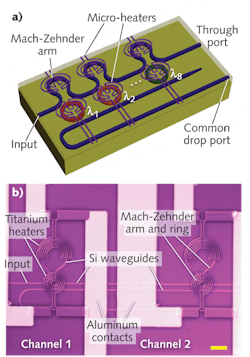SILICON PHOTONICS: Cascaded microrings convert laser pulses for wireless communication

While many additional refinements are still necessary, local-area network device-to-device wireless communications may see a significant speed boost with the conversion of femtosecond laser pulses to radio-frequency (RF) pulses via silicon-photonics-based microring-resonator technology developed by Purdue University (West Lafayette, IN) researchers.1
Recently, ultrabroad-bandwidth arbitrary burst RF waveforms—not easily generated by electronic means due to limits in digital-to-analog technology and high timing jitter—have been generated using ultrafast photonics through spectral shaping and frequency-time mapping of femtosecond laser pulses; however, a critical hurdle is the bulk-optic pulse shaper in these setups that precludes miniaturization and compatibility with electronic integrated circuit (IC) technology. And even though silicon planar lightwave circuit (PLC) and optical fiber Bragg grating (FBG) technology have been used to fabricate spectral pulse shapers, the researchers say that PLCs are much larger in size and not amenable to direct electronic integration, while FBGs lack the programmability needed for arbitrary waveform generation (AWG), which requires the full programmability of the frequency, intensity profile, and relative phases of individual peaks and valleys in an RF pulse.
Cascaded microrings
The Purdue implementation consists of cascaded multiple-channel microring resonators fabricated on a silicon-on-insulator (SOI) platform with a footprint of only 100 × 1200 µm. A modelocked fiber-laser pulse (100 fs in duration) is first amplified and coupled into a silicon waveguide using lensed single-mode fiber tips. In the frequency domain, this ultrashort pulse spans a large bandwidth from 1525 to 1610 nm. The on-chip spectral shaper consists of eight cascaded microring resonators that selectively transfer the optical power at each of their resonant wavelengths from the through-port waveguide to the drop-port waveguide, with each microring creating a peak in the common drop-port spectrum (see figure).
Each ring has a slightly different diameter to create a slightly different resonant wavelength; a micro-heater above each ring also provides additional wavelength tuning. The output from the on-chip spectral shaper then passes through a spool of single-mode optical fiber whose chromatic dispersion broadens the ultrashort pulse envelope, creating a time-domain profile that is a scaled version of the frequency spectrum—a process called frequency-time mapping. Finally, this optical spectrum is converted to an RF signal using a high-speed photodiode. The length of the fiber ranges from approximately 1 to 6 km and currently limits the overall size of the device, admitted Minghao Qi, an assistant professor of electrical and computer engineering at Purdue University, who co-supervised this research. However, Qi says the Purdue team has devised a scheme to integrate the functionality of the fiber spool onto the chip.
Initial experiments produced RF signals at 10 Hz but with little programmability of spectral attenuation for each of the channels due to lack of control in the coupling efficiency of the straight waveguide into the ring. In a second-generation design, Mach-Zehnder input couplers were formed at the through port of each microring, allowing full tuning from an "on" to an "off" state by thermal adjustments of the interferometer arms, and deeper spectral attenuations for improved waveform control.
Being able to completely control wavelength and amplitude of the cascaded microring spectrum allows for the generation of numerous RF waveforms ranging in frequency from 10 to 60 GHz–high-frequency waveforms that challenge even the best time-domain sampling oscilloscopes. Such waveforms promise multigigahertz bandwidths for wireless communication networks, as well as improved chirped radar and cellular radio applications. Researcher Hao Shen, a PhD candidate at Purdue University, says, "The 60 GHz frequency band is open worldwide and our technology offers a working scheme for high-speed local wireless transmission right now." Researcher Maroof Khan, who received a PhD in 2009 and currently works at Intel Corp., adds, "The full compatibility with CMOS technology makes our scheme commercially feasible." Qi and professor Andrew Weiner, Scifres Family Distinguished professor of Electrical and Computer Engineering at Purdue, expect commercialization for 60 GHz wireless communications to occur in the next five years.
REFERENCE
- Maroof H. Khan et al., Nature Photonics 4, p. 117 (February 2010).
About the Author

Gail Overton
Senior Editor (2004-2020)
Gail has more than 30 years of engineering, marketing, product management, and editorial experience in the photonics and optical communications industry. Before joining the staff at Laser Focus World in 2004, she held many product management and product marketing roles in the fiber-optics industry, most notably at Hughes (El Segundo, CA), GTE Labs (Waltham, MA), Corning (Corning, NY), Photon Kinetics (Beaverton, OR), and Newport Corporation (Irvine, CA). During her marketing career, Gail published articles in WDM Solutions and Sensors magazine and traveled internationally to conduct product and sales training. Gail received her BS degree in physics, with an emphasis in optics, from San Diego State University in San Diego, CA in May 1986.